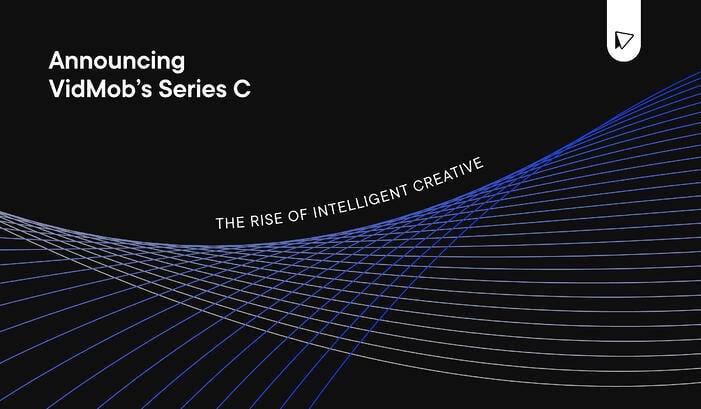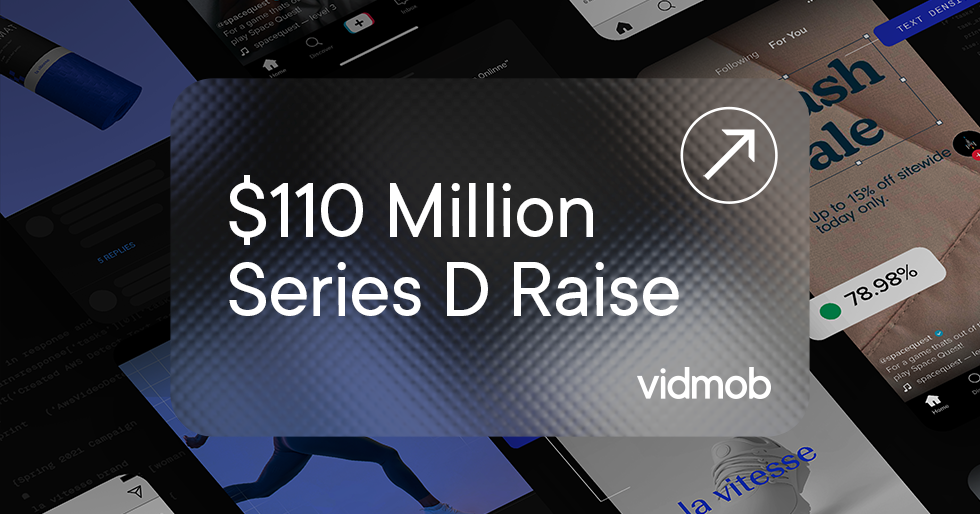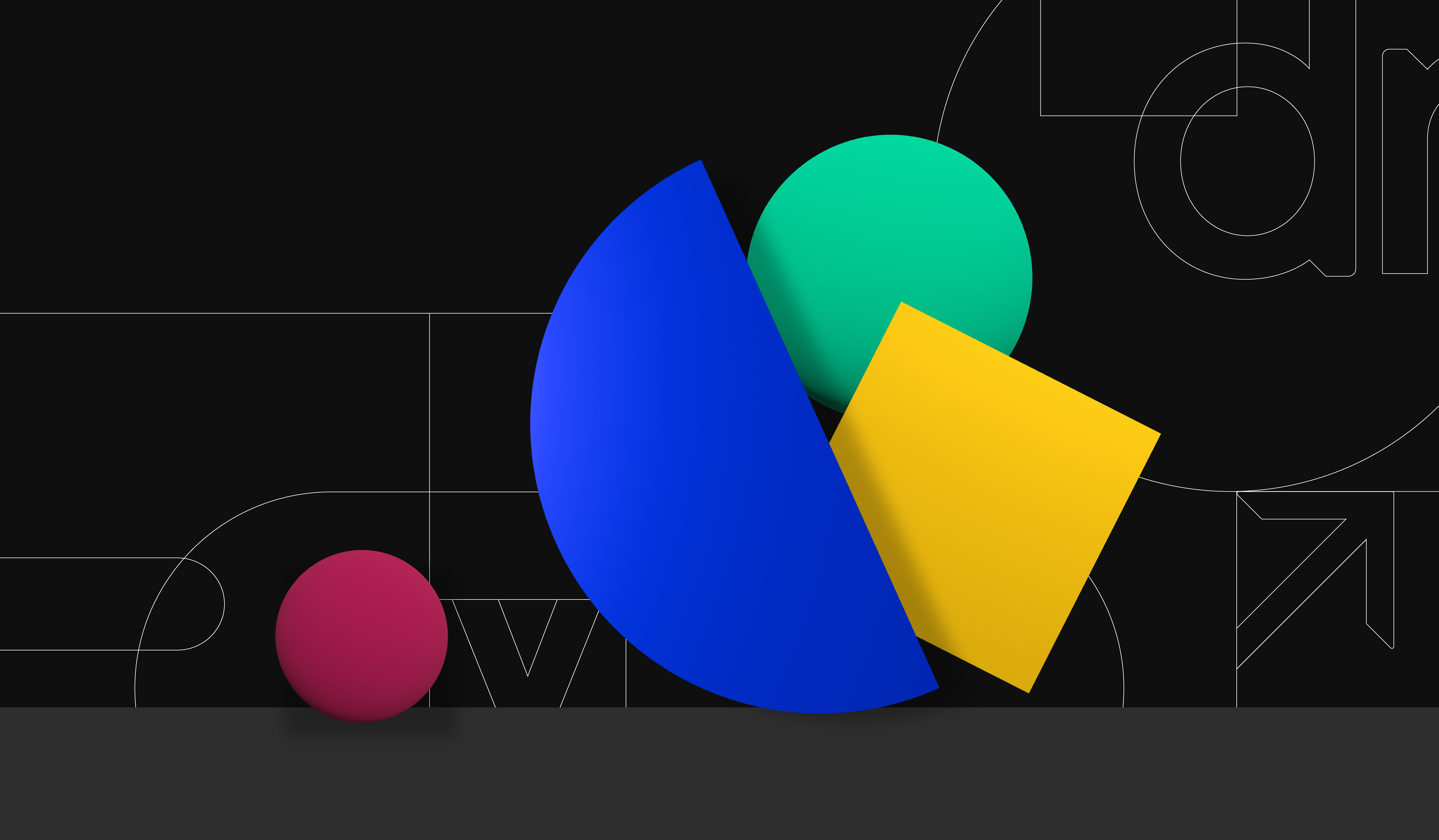Announcing VidMob’s Series D
Amidst a seemingly never-ending stream of negative news in the marketing world these days, as we all collectively wrestle with a slowing economy,...

As a lifelong entrepreneur, I am keenly aware that the process of building a company is part vision, part doggedly pulling on a loose thread, and part story. So, as we announce the closing of VidMob’s Series C and $50 million dollars of expansion capital from a collection of funds who have known us for years, some of the most influential companies in the creative technology space, and a handful of brilliant individuals, I thought it might be helpful to review the unfinished story of VidMob.

In the fall of 2014, I started working on a new project. I was convinced that the internet was transitioning from its static form filled with text and images, to a dynamic future where more complex media-types would dominate screens all around us. And I believed that this would be enormously challenging for anyone trying to communicate online. I was an engineer, so I knew that technology would have to play a role in making those communications more scalable and efficient. But a lifetime of reading, writing and appreciating the arts had trained me to believe unwaveringly in the power of human creativity. I was frustrated by what I’d contributed to the world so far, and I was desperate for a mission. I started speaking with a few friends about my new venture. The first slide (below) was my version of a TAM analysis. The second stated simply that we were going to create a million jobs.

The ‘we’ part of things started to quickly take shape in 2015 and by the end of that year what I would now think of as the founding team of VidMob had been assembled. There were 12 of us. We could see creative friction forming in more and more pockets of the web, and our vision slowly came into focus. If we could build a platform that operated as a sort of API for Creativity, we could eventually distribute it in each of those friction points, and in doing so, build a production layer of the web. And if we controlled that platform, we could control its design to ensure that the jobs it created were good jobs. Our name wouldn’t celebrate $5 work, and there would be no means to sort by the cheapest individual. There would be no way to pit multiple creators against one another and only pay some of them. And while our business didn’t necessarily jump out of the gate, our mission gained further definition.
In time, a few things started to become clear. Creative friction was becoming a real problem and our hybrid model of tech-enabled human creativity was both efficient and drove great results for our clients. We started partnering with platforms like Snapchat and Facebook, and not long after, we closed our Series A financing. We also saw that being a mission-driven company was a strategic advantage, so we tripled down. We started putting the pieces in place for VidMob Gives, a foundation designed to re-use our own platform to help large numbers of charities get free creative. And we expanded from the purely quantitative goal of creating a million jobs, to focusing on evolving creativity for the better. Sure, a better experience and better results for our clients. But also better labor conditions. And better diversity in an industry so desperately in need of it. This attracted better people, and we kept building.

Eventually, this led to the realization that we had the opportunity to help our clients get a better understanding of why their creative was behaving the way it was, and so we began pioneering the idea of Creative Intelligence. It took years, but eventually we had a system that was connected into the ads API’s of every major platform, could enable any client to easily ingest every ad they’d ever run on any platform, programmatically process all of the creative elements in every frame of every ad, and then compare those creative elements to the consumer reactions to every creative impression. We were leading the movement to understand the ‘why’ behind creative performance. This led to the closing of our Series B in the summer of 2019.
As our creative intelligence platform became more and more powerful as a direct result of analyzing the creative drivers of performance for millions of individual ads, we found ourselves in a situation where we had two great products: (i) a truly global managed marketplace of some of the world’s most talented editors, animators and motion designers connected to a multi-award winning work management platform designed to offer infinite scalability to any organization’s marketing efforts, and (ii) a powerful new data product that was pioneering an entirely new category of 1st party data for forward-thinking marketers. In an industry that had permanently separated creative and data nearly 25 years ago in The Great Unbundling, there was a time where this split would have made sense.
But that era is over. Every single company we work with relentlessly adjusts their media targeting parameters (manually or algorithmically) throughout every campaign. However, no one ever changed their creative. It was too expensive. It was too slow. And what data was available, took too long to get back to be of any use.
Of course, this was the case when everything was held separate. But what if we built a software platform to un-do The Great Unbundling, and in the process, bring creative and data together in a way built for the modern era of marketing? So, we spent 18 months focused on becoming an “And” platform — Creative and Data. We knew that if we succeeded in doing this, we could attempt to do what the Tradedesk had done for media, but for the piece that had three times more impact on business results, the actual creative.
This brings us to today. If the first two decades of the internet’s history saw a massive focus on the development of the underlying infrastructure needed to mitigate and remove payment friction, we are now entering the age of creative friction. Want a quick exercise to understand this? Open a Word doc and write a Google Adwords campaign for your company. In 60 seconds you’ll have 4 or 5, and they’ll probably be agency-quality. This is a big part of the reason Google has over 10 million advertisers. Now do the same for an Instagram Stories Ad. Or an AR Lens on Snap? If you’re like most of us, in a month you’ll have nothing. Now consider that marketers are operating in more geographies than ever and communicating on more platforms than ever. Instead of just TV, its TV plus Facebook, Youtube, Snapchat, Instagram, Pinterest, Twitter, Reddit, TikTok, LinkedIn, Amazon, Walmart, Xandr, Hulu, Roku, Spotify, the entire programmatic web, etc. And unlike TV, which didn’t change its essential format for 70 years, every one of these platforms rolls out new formats every few weeks. And TV is starting to do that too!
For a while, people just tried to run TV ads across their digital channels, but now everyone has realized that doesn’t work. Then people tried template tools, but then they realized that if everyone is using the same templates, everyone’s ads look the same, which defeats the whole purpose of communicating — creating a unique, emotionally resonant touch-point with your customer. Make no mistake about it, the needle of complexity always points forward. The future will see more platform proliferation, more format expansion, and a move towards more and more complex media-types (with AR just the next step in the line).
And as if all of this weren’t enough, changing views on privacy have led Apple and Google to make changes to limit/remove cookies, eliminate IDFA and make other changes that are widely expected to move us into a digital advertising environment defined by a general “loss of signal”. For over a decade, advertisers of all sizes have been using the ability to target down to the individual as a crutch to make up for bad creative. But these days are coming to an end and a new paradigm is being born. I don’t think anyone knows exactly what this new world order will look like, as it’s unclear just how impactful these changes will be, but one thing is clear — creative will be more important than ever. After all, if you can’t show an ad with certainty to your target customer, then you need to make creative that speaks to and engages your target customer.
This was the backdrop that led to the completion of VidMob’s $50 million Series C on the heels of a year that started with Inc. Magazine naming us one of the Best Workplaces, and ended with our business nearly doubling despite the global disruption caused by COVID-19. We have always been blessed with incredible investors, and that continues with this latest round. Here are some of the most notable participants who have invested in VidMob to fuel our mission:
Our employees and the creators in our marketplace live and breathe Adobe products. We have been fans of the company for years, and have always admired how they support the creative community. Now, we are excited to dig in together to see how VidMob’s “And” platform can strategically benefit Adobe’s Digital Experience business and Adobe’s Digital Media business.
One of the largest stock media businesses in the world, the alignment with Shutterstock will help accelerate VidMob’s efforts to simplify the process of using data to improve client advertising creative. We were thrilled to see our vision align with that of the Shutterstock leadership team, and we expect our respective clients to benefit significantly from the collaboration.
The fund of Owen Van Natta, Byron Alsberg and Calvin Ling. All three partners have strategically beneficial backgrounds to our business. Most notably, Owen was formerly the COO of Facebook, and spent nearly 8 years as the VP of Worldwide Business Development and Corporate Development at Amazon.
Leaders of VidMob’s Series B, BuildGroup joined again for the Series C. Their partners have been instrumental in helping VidMob improve its operations and we look forward to continuing this work together.
The brilliant founder of Legendary Entertainment. VidMob has had the pleasure of working with Thomas Tull as an advisor over the past year. Now, his investment arm joins as strategic backers of the company. I couldn’t be more thrilled about this, as Thomas is one of the most talented entrepreneurs I’ve ever worked with.
The venture capital firm investing in sports tech and entertainment, created in partnership with one of the savviest performance marketers in the world. We are thrilled to have a partner who can challenge the VidMob product to continue evolving in order to meet the needs of a marketer who is blazing the trail for the future of digital marketing.
One of the new funds to join, we are thrilled to welcome Joe McGowan, Bob Warren and the broader ID Funds team into the family. Their deep industry background will be invaluable as we continue growing the company into future opportunities.
Jamie Nissen’s fund with LP’s like Eric Morgan, the former CEO of Workfront. We are thrilled to work with them and leverage their highly relevant experience to help the SAAS aspects of VidMob’s business accelerate in their growth and development.
Like Thomas, Mainardo had been working with the company as an advisor prior to his investment. Mainardo was formerly the CEO of Aegis, the CEO of OMD Worldwide, and the Executive Vice Chairman of Omnicom Media Group. As VidMob’s agency partnerships continue to grow in importance, Mainardo’s experience and wisdom is expected to be critical in helping VidMob live up to its potential as a neutral software layer for the whole creative industry, not just parts of it.
Nick also brings incredible experience across the agency ecosystem, formerly holding roles including CEO of Dentsu Aegis Network, CEO of iCrossing, CEO of McCann Worldgroup, CEO of Universal McCann, and the CEO of Leo Burnett UK.
One of VidMb’s earliest investors, Interlock Partners joined again and helped lead the round.
Given VidMob’s focus on stakeholder capitalism, and its view of each of the communities it operates in as important stakeholders, getting Milltown involved was particularly exciting for the company. Milltown is a fund based in Pittsfield, MA, where VidMob’s second largest office is located. It is one of the investment vehicles of David Mixer, one of the founding partners of Columbia Capital.
There were other funds and individuals involved. And lists like this never come close to capturing the value that everyone provides to the company. All I can say is this, VidMob would be nowhere without the folks who have backed us and provided guidance to us along the way, and I expect that will remain true into the future. For that, our whole team is incredibly grateful. We know that there are thousands of compelling companies to invest capital in these days, and we take their willingness to entrust us with their capital with an enormous sense of responsibility.
Now that the Series C is behind us, we turn our attention to the future. Our team is bigger now, and it will continue to grow. Similarly, our vision is bigger now. And it too will continue to grow.

All areas of enterprise operations are being impacted by innovative software platforms. In every case, the promise of technology is increased efficiency and greater intelligence leading to improved business results. For many good reasons, creative / marketing operations has lagged behind most other areas of the enterprise in this transition. Creative and data were viewed as incompatible, with neither side trusting the legitimacy of the other’s work. Many companies were working with multiple agencies, so getting them to all use the same systems was difficult or impossible. Visions for in-housing were being tried everywhere, but generally without true utilization of technology, so they really just amounted to moving bodies around. Thus, the results were lackluster.
But all of this is changing now. As Intelligent Creative becomes a category, marketers are not just open to data playing a role in their creative decision-making, they’re demanding it. They are recognizing that when all the key stakeholders in a marketing organization are connected on a single platform, creative can be delivered in timeframes that make data usable in entirely new ways.
We are just getting going here, but if you think about what VidMob really is at its core, you can see where it’s going. We are a software platform designed to help deliver the necessary human services in and around marketing creativity more efficiently and more intelligently. We started with editing, and then expanded to animation and motion design. When we saw that many of our clients needed more ideas, we hired a few creative directors, built software to make their jobs easier, perfected it, and then rolled that service out to the network. We will continue to find tangential services, solve them manually, build software to make our manual solutions scalable and network-enabled, and then move on to the next. Rinse, repeat.
In our data world, human-in-the-loop (‘HITL’) is a popular term. AI systems that incorporate HITL design frequently outperform fully automated systems. Additionally, they are more flexible, more transparent, and in many ways, safer. All of these things matter to us and our clients. But we believe the model can be taken one step further — services-in-the-loop. By creating a whole product that combines creative decision-making, workflow, asset discovery and deployment, performance measurement, creative attribute impact analysis, and human analytics, we can build systems to turn human services (long viewed by technology investors as a negative) into a moat that accelerates the learning of our models. This is where stuff has been getting really interesting for us and our clients, especially recently.
We haven’t created a million jobs yet. But we’re making great progress and we’re only just getting going. And if the slide in the beginning of this post was my version of a TAM analysis, then this is my version of the Table of Contents for the story of VidMob.

There is so much left to do. That includes evolving the culture of the company as we continue to grow, and playing our part in defining what work looks like in a post COVID world. But if any of this sounds interesting to you, and you want to help us fill in the empty pages in the back half of this story, give us a call. This is an enormous opportunity and we could use the help.

Amidst a seemingly never-ending stream of negative news in the marketing world these days, as we all collectively wrestle with a slowing economy,...

In 2017, we aligned on a mission statement for VidMob. We were going to Evolve Creativity for the Better. For six years, this mission guided us...